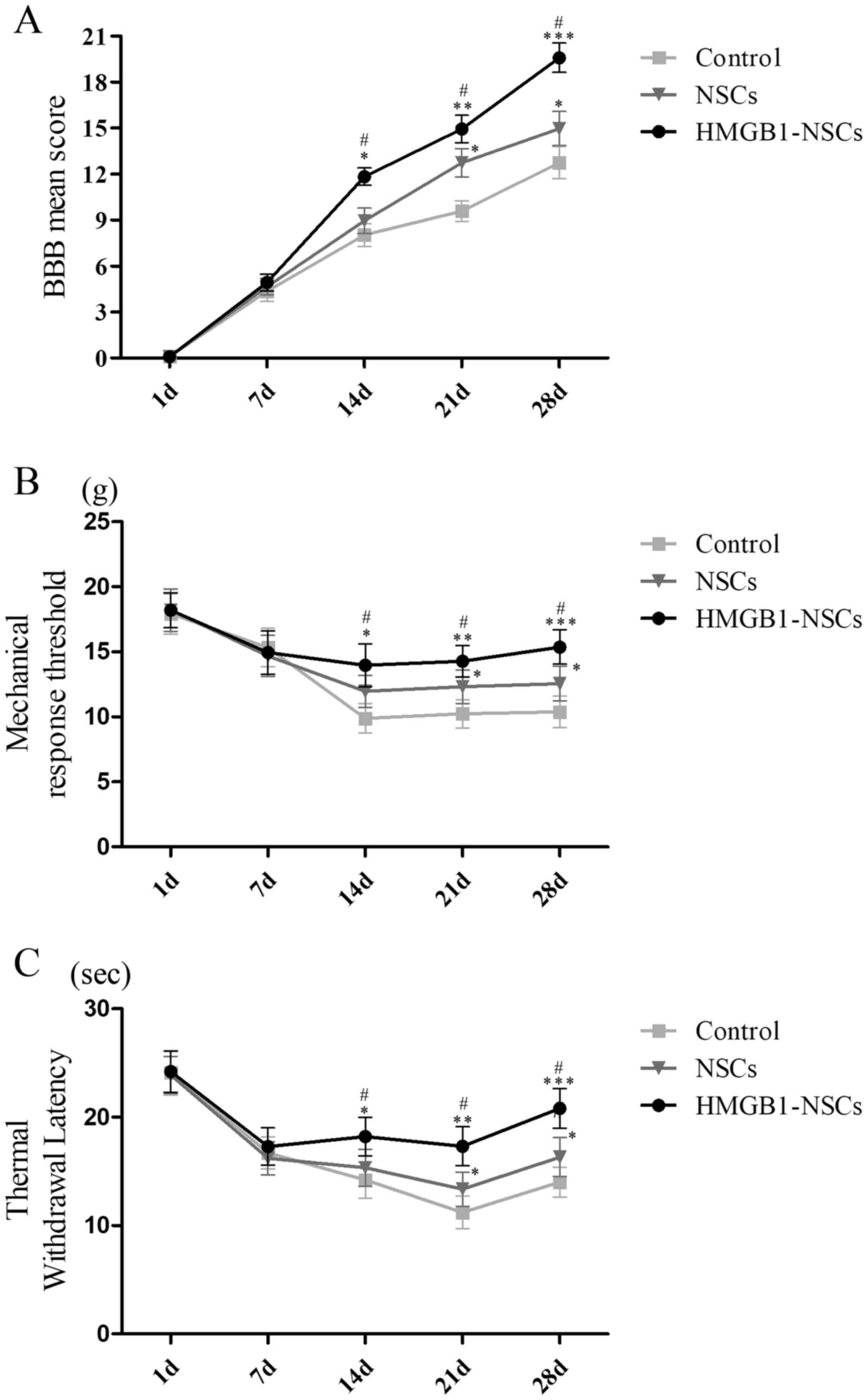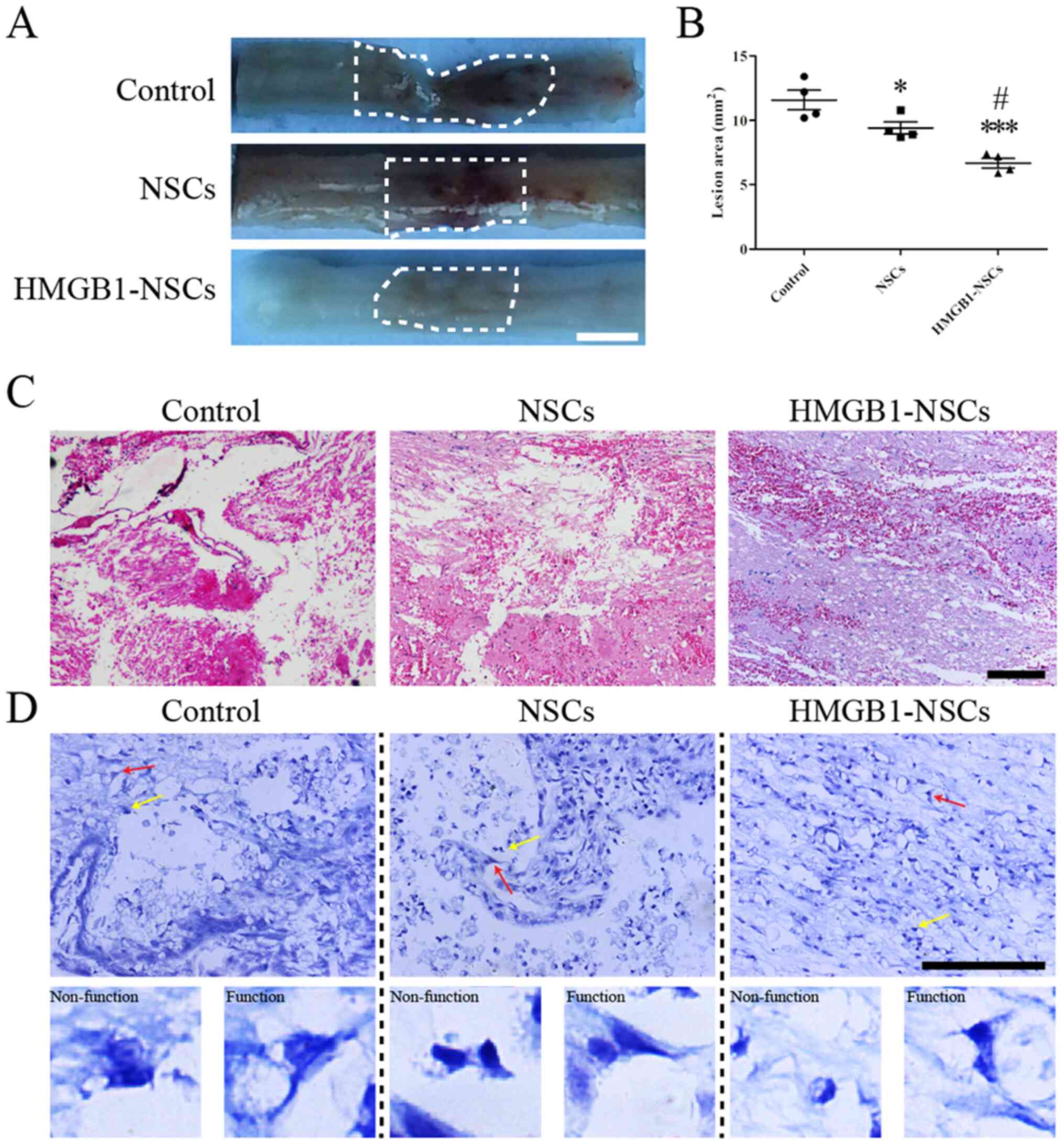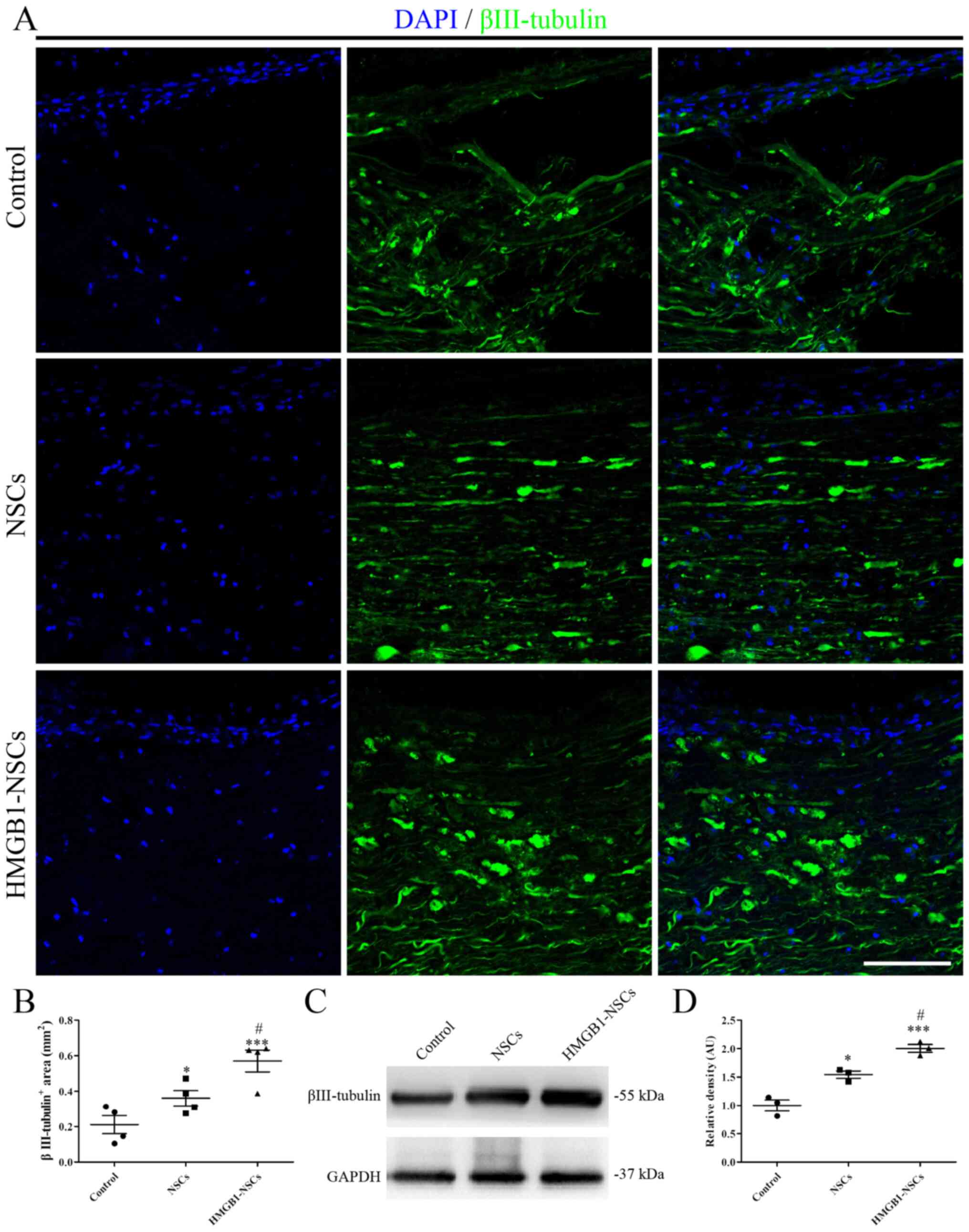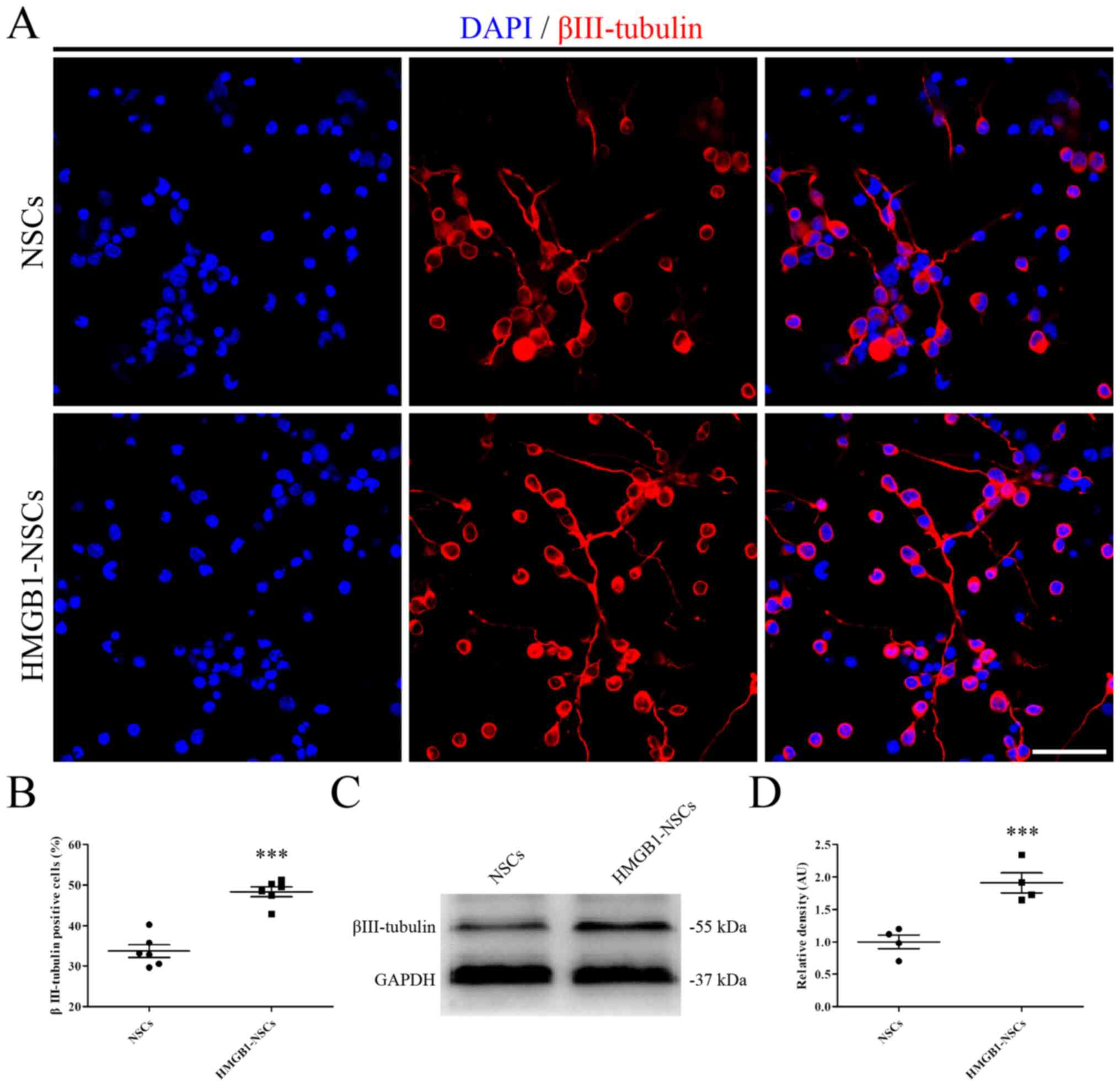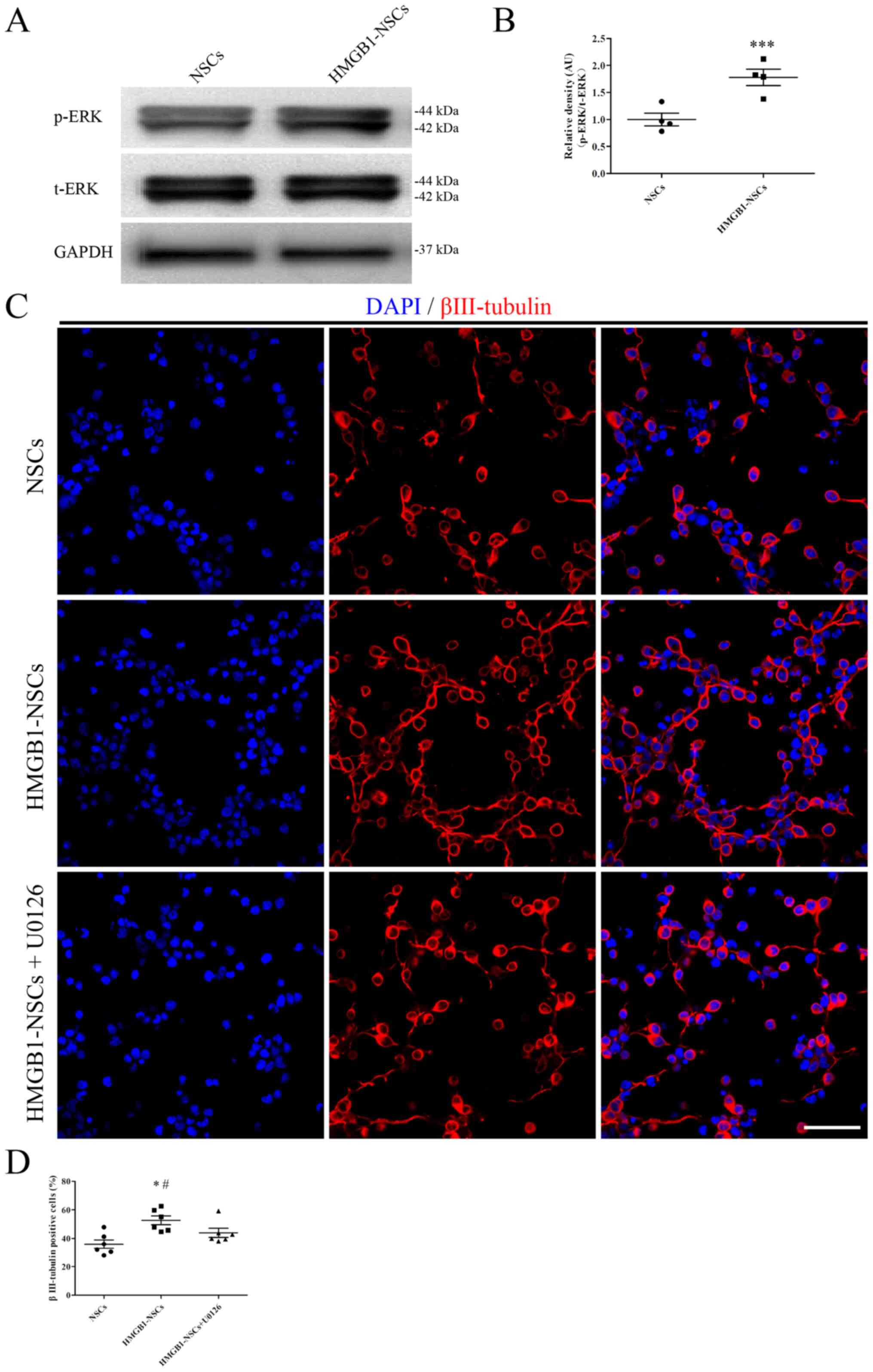|
1
|
Li X, Liu D, Xiao Z, Zhao Y, Han S, Chen B
and Dai J: Scaffold-facilitated locomotor improvement post complete
spinal cord injury: Motor axon regeneration versus endogenous
neuronal relay formation. Biomaterials. 197:20–31. 2019. View Article : Google Scholar : PubMed/NCBI
|
|
2
|
Fan WL, Liu P, Wang G, Pu JG, Xue X and
Zhao JH: Transplantation of hypoxic preconditioned neural stem
cells benefits functional recovery via enhancing neurotrophic
secretion after spinal cord injury in rats. J Cell Biochem.
119:4339–4351. 2018. View Article : Google Scholar : PubMed/NCBI
|
|
3
|
Vismara I, Papa S, Rossi F, Forloni G and
Veglianese P: Current options for cell therapy in spinal cord
injury. Trends Mol Med. 23:831–849. 2017. View Article : Google Scholar : PubMed/NCBI
|
|
4
|
Upadhyay G, Shankar S and Srivastava RK:
Stem cells in neurological disorders: Emerging therapy with
stunning hopes. Mol Neurobiol. 52:610–625. 2015. View Article : Google Scholar : PubMed/NCBI
|
|
5
|
Assinck P, Duncan GJ, Hilton BJ, Plemel JR
and Tetzlaff W: Cell transplantation therapy for spinal cord
injury. Nat Neurosci. 20:637–647. 2017. View Article : Google Scholar : PubMed/NCBI
|
|
6
|
Jin H, Zhang YT, Yang Y, Wen LY, Wang JH,
Xu HY, Lai BQ, Feng B, Che MT, Qiu XC, et al: Electroacupuncture
facilitates the integration of neural stem cell-derived neural
network with transected rat spinal cord. Stem Cell Reports.
12:274–289. 2019. View Article : Google Scholar : PubMed/NCBI
|
|
7
|
Yousefifard M, Rahimi-Movaghar V,
Nasirinezhad F, Baikpour M, Safari S, Saadat S, Moghadas Jafari A,
Asady H, Razavi Tousi SMT and Hosseini M: Neural stem/progenitor
cell transplantation for spinal cord injury treatment; A systematic
review and meta-analysis. Neuroscience. 322:377–397. 2016.
View Article : Google Scholar : PubMed/NCBI
|
|
8
|
Karova K, Wainwright JV, Machova-Urdzikova
L, Pisal RV, Schmidt M, Jendelova P and Jhanwar-Uniyal M:
Transplantation of neural precursors generated from spinal
progenitor cells reduces inflammation in spinal cord injury via
NF-βB pathway inhibition. J Neuroinflammation. 16:122019.
View Article : Google Scholar : PubMed/NCBI
|
|
9
|
Kojima K, Miyoshi H, Nagoshi N, Kohyama J,
Itakura G, Kawabata S, Ozaki M, Iida T, Sugai K, Ito S, et al:
Selective ablation of tumorigenic cells following human induced
pluripotent stem cell-derived neural stem/progenitor cell
transplantation in spinal cord injury. Stem Cells Transl Med.
8:260–270. 2019. View Article : Google Scholar : PubMed/NCBI
|
|
10
|
Hooshmand MJ, Sontag CJ, Uchida N, Tamaki
S, Anderson AJ and Cummings BJ: Analysis of host-mediated repair
mechanisms after human CNS-stem cell transplantation for spinal
cord injury: Correlation of engraftment with recovery. PLoS One.
4:e58712009. View Article : Google Scholar : PubMed/NCBI
|
|
11
|
Babu H, Cheung G, Kettenmann H, Palmer TD
and Kempermann G: Enriched monolayer precursor cell cultures from
micro-dissected adult mouse dentate gyrus yield functional granule
cell-like neurons. PLoS One. 2:e3882007. View Article : Google Scholar : PubMed/NCBI
|
|
12
|
Ronaghi M, Erceg S, Moreno-Manzano V and
Stojkovic M: Challenges of stem cell therapy for spinal cord
injury: Human embryonic stem cells, endogenous neural stem cells,
or induced pluripotent stem cells? Stem Cells. 28:93–99.
2010.PubMed/NCBI
|
|
13
|
Xue X, Chen X, Fan W, Wang G, Zhang L,
Chen Z, Liu P, Liu M and Zhao J: High-mobility group box 1
facilitates migration of neural stem cells via receptor for
advanced glycation end products signaling pathway. Sci Rep.
8:45132018. View Article : Google Scholar : PubMed/NCBI
|
|
14
|
Ge H, Tan L, Wu P, Yin Y, Liu X, Meng H,
Cui G, Wu N, Lin J, Hu R and Feng H: Poly-L-ornithine promotes
preferred differentiation of neural stem/progenitor cells via ERK
signalling pathway. Sci Rep. 5:155352015. View Article : Google Scholar : PubMed/NCBI
|
|
15
|
Basso DM, Beattie MS and Bresnahan JC:
Graded histological and locomotor outcomes after spinal cord
contusion using the NYU weight-drop device versus transection. Exp
Neurol. 139:244–256. 1996. View Article : Google Scholar : PubMed/NCBI
|
|
16
|
Jurga AM, Rojewska E, Piotrowska A, Makuch
W, Pilat D, Przewlocka B and Mika J: Blockade of toll-like
receptors (TLR2, TLR4) attenuates pain and potentiates
buprenorphine analgesia in a rat neuropathic pain model. Neural
Plast. 2016:52387302016. View Article : Google Scholar : PubMed/NCBI
|
|
17
|
Hu R, Zhou J, Luo C, Lin J, Wang X, Li X,
Bian X, Li Y, Wan Q, Yu Y and Feng H: Glial scar and
neuroregeneration: Histological, functional, and magnetic resonance
imaging analysis in chronic spinal cord injury. J Neurosurg Spine.
13:169–180. 2010. View Article : Google Scholar : PubMed/NCBI
|
|
18
|
Liu H, Zhou J, Gu L and Zuo Y: The change
of HCN1/HCN2 mRNA expression in peripheral nerve after chronic
constriction injury induced neuropathy followed by pulsed
electromagnetic field therapy. Oncotarget. 8:1110–1116. 2017.
View Article : Google Scholar : PubMed/NCBI
|
|
19
|
Paudel YN, Semple BD, Jones NC, Othman I
and Shaikh MF: High mobility group box 1 (HMGB1) as a novel
frontier in epileptogenesis: From pathogenesis to therapeutic
approaches. J Neurochem. 151:542–557. 2019. View Article : Google Scholar : PubMed/NCBI
|
|
20
|
Hei Y, Chen R, Yi X, Long Q, Gao D and Liu
W: HMGB1 neutralization attenuates hippocampal neuronal death and
cognitive impairment in rats with chronic cerebral hypoperfusion
via suppressing inflammatory responses and oxidative stress.
Neuroscience. 383:150–159. 2018. View Article : Google Scholar : PubMed/NCBI
|
|
21
|
Uezono N, Zhu Y, Fujimoto Y, Yasui T,
Matsuda T, Nakajo M, Abematsu M, Setoguchi T, Mori S, Takahashi HK,
et al: Prior treatment with anti-high mobility group box-1 antibody
boosts human neural stem cell transplantation-mediated functional
recovery after spinal cord injury. Stem Cells. 36:737–750. 2018.
View Article : Google Scholar : PubMed/NCBI
|
|
22
|
Wang H, Mei X, Cao Y, Liu C, Zhao Z, Guo
Z, Bi Y, Shen Z, Yuan Y, Guo Y, et al: HMGB1/advanced glycation end
products (RAGE) does not aggravate inflammation but promote
endogenous neural stem cells differentiation in spinal cord injury.
Sci Rep. 7:103322017. View Article : Google Scholar : PubMed/NCBI
|
|
23
|
Tirone M, Tran NL, Ceriotti C, Gorzanelli
A, Canepari M, Bottinelli R, Raucci A, Di Maggio S, Santiago C,
Mellado M, et al: High mobility group box 1 orchestrates tissue
regeneration via CXCR4. J Exp Med. 215:303–318. 2018. View Article : Google Scholar : PubMed/NCBI
|
|
24
|
Lei C, Lin S, Zhang C, Tao W, Dong W, Hao
Z, Liu M and Wu B: Effects of high-mobility group box1 on cerebral
angiogenesis and neurogenesis after intracerebral hemorrhage.
Neuroscience. 229:12–19. 2013. View Article : Google Scholar : PubMed/NCBI
|
|
25
|
Wang L, Yu L, Zhang T, Wang L, Leng Z,
Guan Y and Wang X: HMGB1 enhances embryonic neural stem cell
proliferation by activating the MAPK signaling pathway. Biotechnol
Lett. 36:1631–1639. 2014. View Article : Google Scholar : PubMed/NCBI
|
|
26
|
Meneghini V, Bortolotto V, Francese MT,
Dellarole A, Carraro L, Terzieva S and Grilli M: High-mobility
group box-1 protein and β-amyloid oligomers promote neuronal
differentiation of adult hippocampal neural progenitors via
receptor for advanced glycation end products/nuclear factor-κB
axis: Relevance for Alzheimer's disease. J Neurosci. 33:6047–6059.
2013. View Article : Google Scholar : PubMed/NCBI
|















